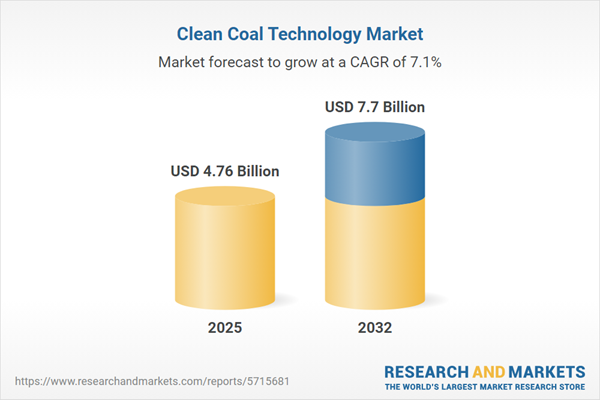Speak directly to the analyst to clarify any post sales queries you may have.
The clean coal technology market is evolving rapidly, as organizations worldwide accelerate the adoption of advanced emissions control and energy security solutions. Senior decision-makers are charting new courses to balance operational reliability, compliance, and long-term sustainability within modern energy portfolios.
Market Snapshot: Clean Coal Technology Market Growth and Outlook
The clean coal technology market continues its upward trajectory, expanding from USD 4.46 billion in 2024 to USD 4.76 billion in 2025, and forecasted to reach USD 7.70 billion by 2032, reflecting a CAGR of 7.06%. Market evolution is being driven by regulatory mandates, increased corporate focus on environmental performance, and innovations that enable emissions reductions and enhanced energy efficiency.
Scope & Segmentation
This report comprehensively analyzes the transformative trends shaping the clean coal technology market for business leaders:
- Technology Type: Carbon capture and storage, multiple classes of combustion (fluidized bed, pulverized coal), and gasification (hydrogen from coal, integrated and multipurpose gasification) are examined across deployments.
- Coal Type: Assessment includes anthracite, bituminous, lignite, and subbituminous, each representing targeted applications and feedstock availability.
- Component: Coverage extends to boilers, various scrubber technologies (dry, wet), and turbines (gas, steam), focusing on their integration into cleaner processes.
- End-User: Market segmentation includes cement production, chemicals (with sub-segments in fertilizer and petrochemicals), power generation plants (coal-fired and combined cycle), and steel manufacturing, highlighting sector-specific adoption patterns.
- Regional Coverage: Insights span the Americas, Europe, Middle East and Africa, and Asia-Pacific, with granular analysis across North and Latin America, Western and Eastern Europe, and emerging markets in Africa and Asia. Key countries and clusters are profiled for market relevance and infrastructure readiness.
- Company Analysis: Reviews of major industry players such as ABB Ltd., Air Products and Chemicals, Inc., General Electric Company, and Mitsubishi Heavy Industries, Ltd. provide competitive benchmarking across strategies and market positioning.
Key Takeaways for Decision-Makers
- Accelerated adoption of carbon capture and gasification is redefining best practices for emission controls in established and emerging markets.
- Regulatory frameworks and carbon pricing play pivotal roles in driving investment toward advanced technologies and upgrades, making compliance and innovation mutually reinforcing.
- Technology alliances and licensing agreements are vital, enabling regional players to minimize supply chain disruptions and reduce reliance on overseas equipment.
- Value chains are shifting, as clean coal components become more modular and digitally integrated for improved monitoring, predictive maintenance, and lifecycle optimization.
- Sector collaborations, especially in hydrogen-from-coal and cross-sector fuel supply, are forging new business models linking chemical manufacturing and power generation.
Tariff Impact on U.S. Supply Chains and Investment Strategies
Recent U.S. tariff measures have introduced complexities across the clean coal technology value chain, affecting procurement costs and supplier selection, particularly for carbon capture modules and specialized gasification equipment. Project developers are responding by shifting towards domestic partnerships, realigning project timelines, and accelerating U.S.-based manufacturing. These adjustments fostered new regional expertise while encouraging policy debate on exemptions that incentivize green technology adoption and ensure supply chain resilience.
Methodology & Data Sources
This analysis synthesizes insights from in-depth interviews with technology developers, regulatory officials, and end-user executives. Supplementary research incorporates peer-reviewed journals, industry white papers, and regulatory databases. Data integrity is maintained through cross-referencing of publicly disclosed metrics, scenario analysis, and validation against industry standards and market disclosures.
Why This Report Matters
- Enables senior leaders to confidently align strategic investments with evolving market, policy, and technology trends.
- Delivers actionable intelligence for targeted segment prioritization, effective risk management, and cross-sector collaboration opportunities.
- Supports compliance, innovation, and operational excellence through rigorous, evidence-based guidance.
Conclusion
Stakeholders leveraging this research will enhance strategic foresight, optimize clean coal technology deployment, and navigate the dynamic global environment with greater clarity and resilience. Informed decision-making today sets the foundation for future sustainable growth.
Additional Product Information:
- Purchase of this report includes 1 year online access with quarterly updates.
- This report can be updated on request. Please contact our Customer Experience team using the Ask a Question widget on our website.
Table of Contents
3. Executive Summary
4. Market Overview
7. Cumulative Impact of Artificial Intelligence 2025
Companies Mentioned
The companies profiled in this Clean Coal Technology market report include:- ABB Ltd.
- Air Products and Chemicals, Inc.
- Aker Solutions ASA
- ALSTOM Holdings
- Arq
- Babcock & Wilcox Enterprises, Inc.
- Bechtel Corporation
- Bharat Heavy Electricals Limited
- Carbon Clean Solutions Limited
- Doosan Corporation
- Exxon Mobil Corporation
- Fluor Corporation
- General Electric Company
- Harbin Electric Company Limited
- Hitachi, Ltd.
- JGC Corporation
- KBR, Inc.
- Linde Engineering Division
- Mitsubishi Heavy Industries, Ltd.
- NextFuel AB
- Shell PLC
- Shenhua Group Corporation Limited
- Siemens AG
Table Information
| Report Attribute | Details |
|---|---|
| No. of Pages | 181 |
| Published | November 2025 |
| Forecast Period | 2025 - 2032 |
| Estimated Market Value ( USD | $ 4.76 Billion |
| Forecasted Market Value ( USD | $ 7.7 Billion |
| Compound Annual Growth Rate | 7.0% |
| Regions Covered | Global |
| No. of Companies Mentioned | 24 |









